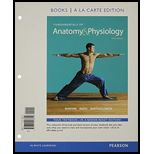
Fundamentals of Anatomy & Physiology, Books a la Carte Edition & Modified MasteringA&P with Pearson eText -- ValuePack Access Card -- for Fundamentals of Anatomy & Physiology Package
1st Edition
ISBN: 9780133974263
Author: Frederic H. Martini, Judi L. Nath, Edwin F. Bartholomew
Publisher: PEARSON
expand_more
expand_more
format_list_bulleted
Concept explainers
Question
Chapter 17, Problem 17RQ
Summary Introduction
To determine:
The three auditory ossicles in the middle ear and their functions.
Introduction:
The ear is the structure on the head of human, which aids in hearing and maintaining the balance of the body. It is divided into three regions namely external ear, middle ear and inner ear. Auditory ossicles are the bones in the middle ear that are important in conveying the vibrations from the tympanic membrane to the basilar membrane. The bones are malleus, incus and stapes.
Expert Solution & Answer
Want to see the full answer?
Check out a sample textbook solution
Students have asked these similar questions
What is the relationship between the middle ear bones and the cochlea?
What and where is the optic disc, and why is it important?
(a) What is the difference, if any, between a semicircular canal and semicircular duct? Between the cochlea and cochlear duct? (b) Name the three parts of the membranous labyrinth of the internal ear. Which of these parts is for hearing, and which are for balance?
Chapter 17 Solutions
Fundamentals of Anatomy & Physiology, Books a la Carte Edition & Modified MasteringA&P with Pearson eText -- ValuePack Access Card -- for Fundamentals of Anatomy & Physiology Package
Ch. 17 - Prob. 1CPCh. 17 - Prob. 2CPCh. 17 - Prob. 3CPCh. 17 - Prob. 4CPCh. 17 - If you completely dry the surface of your tongue...Ch. 17 - Prob. 6CPCh. 17 - Prob. 7CPCh. 17 - Prob. 9CPCh. 17 - Prob. 10CPCh. 17 - Prob. 8CP
Ch. 17 - Prob. 11CPCh. 17 - Prob. 12CPCh. 17 - Prob. 13CPCh. 17 - Prob. 14CPCh. 17 - Prob. 15CPCh. 17 - Prob. 16CPCh. 17 - Prob. 1RQCh. 17 - Prob. 2RQCh. 17 - A blind spot occurs in the retina where (a) the...Ch. 17 - Sound waves are convened into mechanical movements...Ch. 17 - The basic receptors in the internal ear are the...Ch. 17 - Prob. 6RQCh. 17 - At sunset, your visual system adapts to (a) fovea...Ch. 17 - Prob. 8RQCh. 17 - The malleus, incus, and stapes are the tiny bones...Ch. 17 - Identify the structures of the external, middle,...Ch. 17 - Prob. 11RQCh. 17 - Prob. 12RQCh. 17 - Prob. 13RQCh. 17 - Prob. 14RQCh. 17 - Prob. 15RQCh. 17 - Prob. 16RQCh. 17 - Prob. 17RQCh. 17 - Prob. 18RQCh. 17 - Prob. 19RQCh. 17 - Prob. 20RQCh. 17 - Prob. 21RQCh. 17 - Prob. 22RQCh. 17 - Prob. 23RQCh. 17 - Prob. 24RQCh. 17 - Prob. 25RQCh. 17 - Prob. 26RQCh. 17 - Prob. 27RQCh. 17 - Prob. 28RQCh. 17 - Prob. 1CCCh. 17 - Prob. 2CC
Knowledge Booster
Learn more about
Need a deep-dive on the concept behind this application? Look no further. Learn more about this topic, biology and related others by exploring similar questions and additional content below.Similar questions
- Apart from the bony boundaries, which structure separates the external from the middle ear? Which two (nonbone) structures separate the middle from the inner ear?arrow_forwardWhere are the auditory ossicles located, and what is their function?arrow_forwardWhat are the membranous labyrinth structures, and what is the specific bony labyrinth structure in which each resides?arrow_forward
- What are the roles of the cochlea and auditory nerve in hearing?arrow_forwardDescribe the overall function of the three bones (the malleus, the incus, and the stapes) of the middle ear.arrow_forwardWhich of the following is not part of the auditory ossicles in the middle ear? a) No answer text provided. b) incus (the city) c) malleus (hammaren) d) stapedius (the step)arrow_forward
arrow_back_ios
SEE MORE QUESTIONS
arrow_forward_ios
Recommended textbooks for you
 Human Anatomy & Physiology (11th Edition)BiologyISBN:9780134580999Author:Elaine N. Marieb, Katja N. HoehnPublisher:PEARSON
Human Anatomy & Physiology (11th Edition)BiologyISBN:9780134580999Author:Elaine N. Marieb, Katja N. HoehnPublisher:PEARSON Biology 2eBiologyISBN:9781947172517Author:Matthew Douglas, Jung Choi, Mary Ann ClarkPublisher:OpenStax
Biology 2eBiologyISBN:9781947172517Author:Matthew Douglas, Jung Choi, Mary Ann ClarkPublisher:OpenStax Anatomy & PhysiologyBiologyISBN:9781259398629Author:McKinley, Michael P., O'loughlin, Valerie Dean, Bidle, Theresa StouterPublisher:Mcgraw Hill Education,
Anatomy & PhysiologyBiologyISBN:9781259398629Author:McKinley, Michael P., O'loughlin, Valerie Dean, Bidle, Theresa StouterPublisher:Mcgraw Hill Education, Molecular Biology of the Cell (Sixth Edition)BiologyISBN:9780815344322Author:Bruce Alberts, Alexander D. Johnson, Julian Lewis, David Morgan, Martin Raff, Keith Roberts, Peter WalterPublisher:W. W. Norton & Company
Molecular Biology of the Cell (Sixth Edition)BiologyISBN:9780815344322Author:Bruce Alberts, Alexander D. Johnson, Julian Lewis, David Morgan, Martin Raff, Keith Roberts, Peter WalterPublisher:W. W. Norton & Company Laboratory Manual For Human Anatomy & PhysiologyBiologyISBN:9781260159363Author:Martin, Terry R., Prentice-craver, CynthiaPublisher:McGraw-Hill Publishing Co.
Laboratory Manual For Human Anatomy & PhysiologyBiologyISBN:9781260159363Author:Martin, Terry R., Prentice-craver, CynthiaPublisher:McGraw-Hill Publishing Co. Inquiry Into Life (16th Edition)BiologyISBN:9781260231700Author:Sylvia S. Mader, Michael WindelspechtPublisher:McGraw Hill Education
Inquiry Into Life (16th Edition)BiologyISBN:9781260231700Author:Sylvia S. Mader, Michael WindelspechtPublisher:McGraw Hill Education

Human Anatomy & Physiology (11th Edition)
Biology
ISBN:9780134580999
Author:Elaine N. Marieb, Katja N. Hoehn
Publisher:PEARSON

Biology 2e
Biology
ISBN:9781947172517
Author:Matthew Douglas, Jung Choi, Mary Ann Clark
Publisher:OpenStax

Anatomy & Physiology
Biology
ISBN:9781259398629
Author:McKinley, Michael P., O'loughlin, Valerie Dean, Bidle, Theresa Stouter
Publisher:Mcgraw Hill Education,

Molecular Biology of the Cell (Sixth Edition)
Biology
ISBN:9780815344322
Author:Bruce Alberts, Alexander D. Johnson, Julian Lewis, David Morgan, Martin Raff, Keith Roberts, Peter Walter
Publisher:W. W. Norton & Company

Laboratory Manual For Human Anatomy & Physiology
Biology
ISBN:9781260159363
Author:Martin, Terry R., Prentice-craver, Cynthia
Publisher:McGraw-Hill Publishing Co.

Inquiry Into Life (16th Edition)
Biology
ISBN:9781260231700
Author:Sylvia S. Mader, Michael Windelspecht
Publisher:McGraw Hill Education